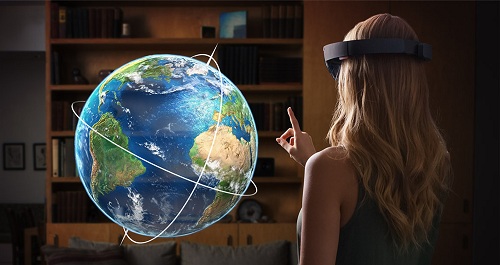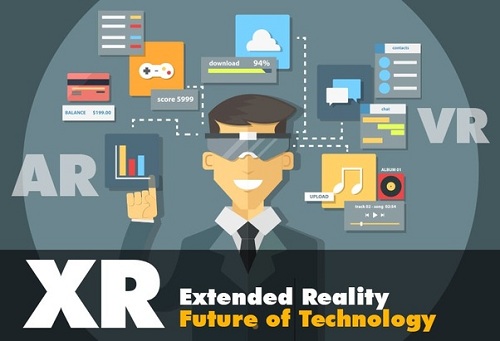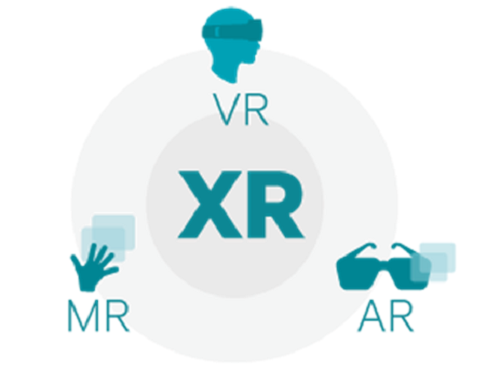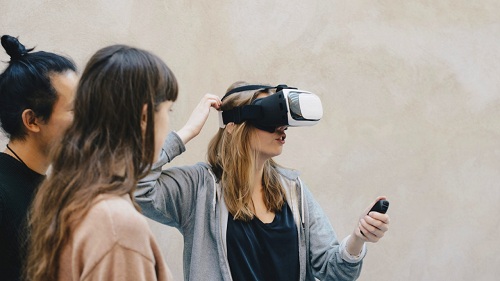
Fig. 1: Immersive technology – Newer ways to interact
Recent years have seen a series of exponential technological advances, innovation and invention manifested in variousways such as cloud, artificial intelligence, blockchain, augmented and virtual reality, Internet of things (Iot), robotics, quantum computing, and so on. This technology revolution represents vast potential for changing how human beings live, work, learn and share today, tomorrow and beyond.According to Accenture Technology Vision 2018, there is a paradigm shift in the role of business itself: it is moving closer to the centre of people’s lives. With the growing application of digital technologies by companies across the world, traditional boundaries between business and personal do not seem to exist anymore. Moving beyond providing products and services, companies are applying technology to forge deeper, more collaborative relationships with people.
Leveraging the rapid advancements in technology to develop increasingly innovative products and services, businesses are driving phenomenal changes in the social and business world.Technology-based products and services have a tremendous impact on the way people work and live today. Through those products and services, businesses are driving unprecedented change everywhere. But in exchange for the limitless access and influence companies enjoy today, people are expecting them to play a more responsible and ethical role.Such expectations are not simply confined to customers, but encompass employees, business partners, governments, and society as a whole.
Making sense of AI
Artificial intelligence (AI) can be defined as a collection of advanced technologies that allows machines to sense, comprehend, act, and learn. As AI grows in its capabilities—and its impact on people’s lives—businesses are beginning to feel the need to “raise” their AI to act as a responsible, responsive and productive member of Planet Earth.

Fig. 2: In Perspective – Newer dimensions of reality
In fact, the continuously evolving digital culture creates challenges as well asopportunities for organizations globally. From the very beginning of the digital era, businesses have been evolving themselves with each passing year.They are growing more involved in people’s lives; embracing the “People First” view of the changing enterprise landscape. We have reached at a point of fusion: businesses are looking to touch lives, and it can happen only by forging partnerships with citizensand helping make this world a better place for its inhabitants.
AI has become a company’s virtualface. Moving beyond a backend tool for the enterprise, it is taking on more sophisticated roles within technology interfaces. From autonomous driving vehicles that use computer vision, to live translations made possible by artificial neural networks, AI is making every interface both simple and smart—and setting a high bar for how future interactions will work.
It is being increasingly realized that to gain the trust of individuals, ecosystems, and regulators in the digital economy, businesses must provide a sense ofreassurance and ethics to their customers and clients. And new products and services must provide a sense of ease and security to the users.
With AI growing in its reach throughout society, businessesare looking to capitalize on its potential to impact and transform the world.Going beyond being a technological tool, AI has reached the level where it frequently has as much influence as the people making use of it, both within and outside the company.For companies, this amounts to deploying AI to not just train it to perform a given task, but “raising” it to act as a participative and a contributing member of thebusiness and society.
AI systems learn, take autonomous decisions, and are no longer mere technological tools. With increasing autonomy and sophisticated capabilities, they have now grown to partners among people, coordinating and collaborating with peopleeverywhere.Their influence is all pervasive in all spheres.
Growing potential of Extended Reality (XR)
Immersive experiences are changing the way people connect with information, experiences, and each other. The integration of AIwith Augmented Reality (AR) andVirtual Reality (VR) provides a new range of experiences and opportunities. While AR is the technology which overlays digital information into the real world, VR immerses a user in a solely digital world, with the use of a head mounted display.

Fig. 3: Seamless fusion – human-machine interaction at best
Encompassingthe convergence of AR and VR, Extended Reality (XR) is the first technology to “relocate” people in time and space—and it’s bringing about the end of distance.XR refers to the spectrum of experiences that blurs the line between the real world and the simulated environments. With immersive environments making it possible for employees to “be” anywhere, XR-based solutions and innovations leading to human-machine interactions are growing across the workforce and throughout customer facing products and services.

Fig. 4: Ultimate Convergence – combining real & virtual worlds
Real estate company Redfin made its name by embracing technology, so it’s no surprise that the company has adopted VR to sell homes. Powered by technology from Matterport, Redfin’s 3D, real-world listings can be “toured” without ever setting foot on the property. VR start-up Virtual Xperience lets builders show and sell “pre-construction” projects, inviting potential buyers to experience the completed space from anywhere—even if all that exists today is an empty lot.
Companies across industries, and even entire industries, have been built around the most basic and intractable principle of “needed here, but exists there.” This challenge impacts everyone, from people with busy schedules trying to buy groceries, to companies struggling with talent shortages because the locally available skills don’t match theirneeds. Removing distance barriers is a driver in their adoption of XR solutions.
Following years of relative stagnation, the corporate training industry is expected to grow at 10 percent CAGR from 2017 through 2020. Its growth is driven by the need to train or reskill increasingly distributed and far-flung workers for a decidedly digital future, making employee training ripe for transformation with XR. Companies can bring trainers “offsite” from anywhere, or have students virtually “travel” to an instructor; training scenarios can be set up anywhere, then run, re-run, and adjusted to give a first-hand experience of different situations. XR eliminates the distance not just between student and teacher, but also concept and practice.

Fig. 5: Transforming workplace – XR eliminates distance
By placing people directly into whatever setting that trainers can dream up, XR delivers first-hand experience with challenging or potentially dangerous situations without real-world risk.
XR will also help businesses address the largest workforce challenge they face: the distance between themselves and the talent they need to grow. The technology supports an on-demand workforce approach, which not only saves in recruitment costs, but also helps businesses engage an ever-growing pool of talent who desires flexibility. Through immersive experiences, businesses can tap expertise in thousands of skills from anywhere in the world.
What’s more, as XR-based remote control of physical systems becomes common, companies will be able to hire for manufacturing, assembly, and robotics expertise from a global pool of the best candidates, regardless of where they live.
Revolutionized workforce training and expanded access to expertise are just the beginning of what XR can accomplish for business, and they’re actionable—and immediately beneficial—options for the enterprise today. Embracing immersive technologies for training benefits companies, from the recruiting process, to enhancing the skills of long-time employees.
XR is helping to eliminate the distance between employees and the information they need to get work done. On factory floors, it’s reducing the need for written instructions: GE Renewable Energy is using AR to deliver assembly information, improving worker productivity in wiring wind turbines by 34 percent.
Consumers are also making purchase decisions from information delivered via XR technologies. Audi uses VR to let prospective customers design and tour their own custom vehicle, while BMW offers an AR-driven exploration of its models, even letting people get “inside” the car to explore.
Emerging XR tools express data in 3D environments, closer to the way humans actually see and imagine scenarios. This clears the way for new types of visualizations—and new discoveries. The Body VR creates interactive 3D builds of traditionally 2D medical imaging, like CT scans and MRIs, to provide a more intuitive view of medical conditions. Similarly, Oxford researchers have created VR models of genetic data to better visualize what happens within living cells.
Besides, XR has also demonstrated value in unlearning: researchers have seen compelling results using VR therapy to address post-traumatic stress disorder in military veterans, letting patients confront triggering stressors while talking through their responses with therapists in real time.
Conclusion
Throughout history, technologies have evolved to minimize distance—from the wheel to the Internet, technology closes the gap. Today, real estate is experimenting with virtual home tours; soon, XR will transform what developers build to include optimizations for remote work, enabling people to do their jobs from anywhere. In the distant future, they’ll integrate features that let people dynamically change rooms from an office environment at one moment, to a retail store for shopping the next, without physically moving an inch.
As XR technology makes immersive experiences commonplace, it does away with distance, minimizing its relevance. Today, XR is still evolving, and challenges around processing lag and content creation remain barriers to its full maturity. As today’s technical limitations are addressed, XR will only grow in capability and impact. To prepare for a world where the most powerful experiences might be virtual, businesses must focus on tactical uses of it today. Making well-planned forays into immersive experiences now will help build the capabilities needed to transform entire industries tomorrow.
Filed Under: Tech Articles


Questions related to this article?
👉Ask and discuss on EDAboard.com and Electro-Tech-Online.com forums.
Tell Us What You Think!!
You must be logged in to post a comment.